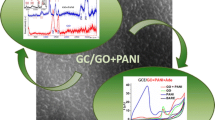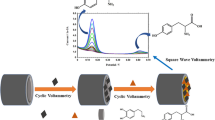Abstract
The surface of a glassy carbon electrode (GCE) was modified by electropolymerization of acridine red followed by drop-coating of graphene. The morphology was characterized by scanning electron microscopy. Uric acid (UA) is effectively accumulated on the surface of the modified electrode and generates a sensitive anodic peak in solutions of pH 6.5. Differential pulse voltammetry was used to evaluate the electrochemical response of the modified GCE to UA. Compared to the bare GCE, the GCE modified with acridine red, and to the graphene modified electrode, the new GCE displays high electrochemical activity in giving an oxidation peak current that is proportional to the concentration of UA in the range from 0.8 to 150 μM, with a detection limit of 0.3 μM (at an S/N of 3). The modified electrode displays excellent selectivity, sensitivity, and a wide linear range. It has been applied to the determination of UA in real samples with satisfactory results.

The surface of a glassy carbon electrode was modified by electropolymerization of acridine red onto its surface and then covering it with graphene dropped. The graphene-poly(acridine red) modified electrode displays high electrochemical activity in giving an oxidation peak current that is proportional to the concentration of uric acid in a certain range.






Similar content being viewed by others
References
Kim KY, Schumacher HR, Hunsche E, Wertheimer AI, Kong SX (2003) A literature of the epidemiology and treatment of acute gout. Clin Ter 25:1593
Kalimuthu P, John SA (2009) Simultaneous determination of epinephrine, uric acid and xanthine in the presence of ascorbic acid using an ultrathin polymer film of 5-amino-1,3,4-thiadiazole-2-thiol modified electrode. Anal Chim Acta 647:97
Zhu SY, Li HJ, Niu WX, Xu GB (2009) Simultaneous electrochemical determination of uric acid, dopamine, and ascorbic acid at single-walled carbon nanohorn modified glassy carbon electrode. Biosens Bioelectron 25:940
Hausen A, Fuchs D, Knig K, Wachter H (1981) Quantitation of urinary uric acid by reversed-phase liquid chromatography. Clin Chem 27:1455
Galban Y, Andreu Y, Almenara MJ, de Marcos S, Castillo JR (2001) Direct determination of uric acid in serum by a fluorometric-enzymatic method based on uricase. Talanta 54:847
Silva MLS, Garcia MBQ, Lima JLFC, Santos JLM, Barrado E (2005) Multicommutated flow system with amperometric detection. Determination of uric acid in urine. Electroanalysis 23:2156
Garcia MBQ, Lima JFLC, Silva ML, Sousa JP (2004) Automatic determination of uric acid in urine in a FIA system with tubular amperometric detector. Portugaliae Electrochim Acta 22:249
Fang B, Feng YH, Wang GF, Zhang CH, Gu AX, Liu M (2011) A uric acid sensor based on electrodeposition of nickel hexacyanoferrate nanoparticles on an electrode modified with multi-walled carbon nanotubes. Microchim Acta 173:27
Kurşun S, Paşahan A, Ekinci BZ, Ekinci E (2011) Poly(3-aminophenol) film as a uric acid-selective electrode. Int J Polym Mater 60:365
Ardakani MM, Taleat Z, Beitollahi H, Naeimi H (2011) Electrocatalytic determination of epinephrine and uric acid using a novel hydroquinone modified carbon paste electrode. Chinese Chem Lett 22:705
Wang YZ (2011) The electrochemistry of uric acid at a gold electrode modified with L-cysteine, and its application to sensing uric urine. Microchim Acta 172:419
Habibi B, Pezhhan H, Hossien M, Azar P (2011) Voltammetric and amperometric determination of uric acid at a carbon-ceramic electrode modified with multi walled carbon nanotubes. Microchim Acta 169:313
Stankovich S, Dikin DA, Dommett GHB, Kohlhaas KM, Zimney EJ, Stach EA, Piner RD, Nguyen ST, Ruoff RS (2006) Graphene-based composite materials. Nature 442:282
Novoselov KS, Geim AK, Morozov SV, Jiang D, Zhang Y, Dubonos SV, Grigorieva IV, Firsov AA (2004) Electric field effect in atomically thin carbon films. Science 306:666
Geim AK, Novoselov KS (2007) The rise of graphene. Nat Mater 6:183
Schedin F, Geim AK, Morozov SV, Hill EW, Blake P, Katsnelson MI, Novoselov KS (2007) Detection of individual gas molecules adsorbed on graphene. Nat Mater 6:652
Huang JS, Liu Y, Hou HQ, You TY (2008) Simultaneous electrochemical determination of dopamine, uric acid and ascorbic acid using palladium nanoparticle-loaded carbon nanofibers modified electrode. Biosens Bioelectron 24:632
Zhou M, Zhai YM, Dong SJ (2009) Electrochemical sensing and biosensing platform based on chemically reduced graphene oxide. Anal Chem 81:5603
Lim CX, Hoh HY, Ang PK, Loh KP (2010) Direct Voltammetric detection of DNA and pH sensing on epitaxial graphene: an insight into the role of oxygenated defects. Anal Chem 82:7387
Gan T, Hu SS (2011) Electrochemical sensors based on graphene materials. Microchim Acta 175:1
Shang NG, Papakonstantinou P, McMullan M, Chu M, Stamboulis A, Potenza A, Dhesi SS, Marchetto H (2008) Catalyst-free efficient growth, orientation and biosensing properties of multilayer graphene nanoflake films with sharp edge planes. Adv Funct Mater 18:3506
Sun CL, Lee HH, Yang JM, Wu CC (2011) The simultaneous electrochemical detection of ascorbic acid, dopamine, and uric acid using graphene/size-selected Pt nanocomposites. Biosens Bioelectron 26:3450
Zhang Y, Zhuang HS (2011) Poly(acridine orange) film modified electrode for the determination 1-naphthol in the presence of 2-naphthol. Electrochim Acta 54:7364
Zhang YZ, Jin GY, Wang YL, Yang ZS (2003) Determination of dopamine in the presence of ascorbic acid using poly (acridine red) modified glassy carbon electrode. Sensors 3:443
Wang ZH, Zhang D, Zhang Y, Zhou SP (2004) Preparation of poly(acridine red) modified electrode and its application. Chin J Appl Chem 21:566
Wei SH, Zhao FQ, Zeng BZ (2005) Electrochemical behavior and determination of uric acid at single-walled carbon nanotube modified gold electrodes. Microchim Acta 150:219
Ren W, Luo HQ, Li NB (2006) Simultaneous voltammetric measurement of ascorbic acid, epinephrine and uric acid at a glassy carbon electrode modified with caffeic acid. Biosens Bioelectron 21:1086
Li P, Wu SG, Zhang HC, Ma CX (2005) Electrochemical behavior of uric acid on prussian blue modified electrode and its application to the analytical chemistry. Chin J Anal Chem 33:77
Rodríguez MC, Sandoval J, Galicia L, Gutiérrez S, Rivas GA (2008) Highly selective determination of uric acid in the presence of ascorbic acid at glassy carbon electrodes modified with carbon nanotubes dispersed in polylysine. Sensor Actuat B-Chem 134:559
Chauhan N, Pundir CS (2011) An amperometric uric acid biosensor based on multiwalled carbon nanotube–gold nanoparticle composite. Anal Biochem 413:97
Akbari R, Noroozifar M, Khorasani-Motlagh M, Taheri A (2010) Simultaneous determination of ascorbic acid and uric acid by a new modified carbon nanotube-paste electrode using chloromercuriferrocene. Anal Sci 26:425
Zhang L, Shi ZG, Lang QH (2011) Fabrication of poly(orthanilic acid)–multiwalled carbon nanotubes composite film-modified glassy carbon electrode and its use for the simultaneous determination of uric acid and dopamine in the presence of ascorbic acid. J Solid State Electr 15:801
Yang SL, Li G, Yang R, Xia MM, Qu LB (2011) Simultaneous voltammetric detection of dopamine and uric acid in the presence of high concentration of ascorbic acid using multi-walled carbon nanotubes with methylene blue composite film-modified electrode. J Solid State Electr 15:1909
Yuan Y, Ahammad AJS, Xu GR, Kim SU, Lee JJ (2008) Poly(thionine)-modified GC electrode for simultaneous detection of dopamine and uric acid in the presence of ascorbic acid. B Korean Chem Soc 29:1883
Huang SH, Liao HH, Chen DH (2010) Simultaneous determination of norepinephrine, uric acid, and ascorbic acid at a screen printed carbon electrode modified with polyacrylic acid-coated multi-wall carbon nanotubes. Biosens Bioelectron 25:2351
Manjunathaa R, Suresha GS, Melob JS, F.D’Souzab S, Venkateshac TV (2010) Simultaneous determination of ascorbic acid, dopamine and uric acid usin polystyrene sulfonate wrapped multiwalled carbon nanotubes bound to graphite electrode through layer-by-layer technique. Sensor Actuat B-Chem 145:643
Xue Y, Zhao H, Wu ZJ, Li XJ, He YJ, Yuan ZB (2011) The comparison of different gold nanoparticles/graphene nanosheets hybridnanocomposites in electrochemical performance and the construction of a sensitive uric acid electrochemical sensor with novel hybrid nanocomposites. Biosens Bioelectron 29:102
Acknowledgments
This work was supported by the National Natural Science Foundation of China (No. 20975083), the Municipal Science Foundation of Chongqing City (No. CSTC–2008BB 4013), and the 211 Project of Southwest University (the Third Term).
Author information
Authors and Affiliations
Corresponding author
Electronic supplementary material
Below is the link to the electronic supplementary material.
ESM 1
(DOC 1398 kb)
Rights and permissions
About this article
Cite this article
Li, Y., Ran, G., Yi, W.J. et al. A glassy carbon electrode modified with graphene and poly(acridine red) for sensing uric acid. Microchim Acta 178, 115–121 (2012). https://doi.org/10.1007/s00604-012-0820-7
Received:
Accepted:
Published:
Issue Date:
DOI: https://doi.org/10.1007/s00604-012-0820-7




